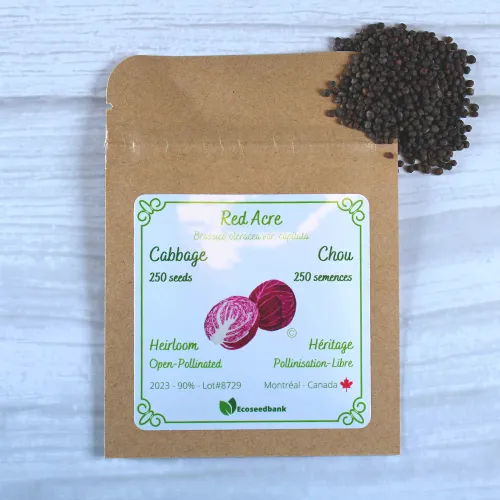Red Acre is an early maturing variety of red cabbage that produces reddish-purple heads, growing to seven inches wide and weighing about three pounds. It’s a colorfoul addition to your garden that is delicious to add to a salad, stir fry or coleslaw.
GROWING INSTRUCTIONS
Growing your own cabbage patch is quite a satisfying deed. It is cheap enough at the market, but nothing beats fresh homegrown. Cabbage has myriad of uses and health benefits.
Start seeds indoors 4-6 weeks before the date of the last spring frost. Plant the seeds into flats about 1 cm deep and 2 cm apart. While inside, keep seeds moist, warm and well lit.
Cabbage will do best in long cool growing seasons. It can tolerate frost and temporary temperatures down to -6°C, but will bolt and seed in temperatures above 26°C. Transplant seedlings into the garden when they are 10-15 cm tall. Space them about 45-60 cm in rows 60-90 cm apart. Harden off young plants for a couple weeks to acclimate them to the sun and then transplant as early as 3 weeks before the last frost is expected.
If your region experiences cool summers, seeds can be sown directly in late spring for a fall harvest. Give cabbage 3-5 cm of water/week but decrease that amount close to harvest time to prevent the heads from splitting. Mulch around cabbages and feed every 2 weeks with a mild nitrogen fertilizer.
The heads will be ready to harvest anywhere from 80-160 days depending on the variety. Cut the heads in spring before the weather gets too warm. In the late fall and winter, they will withstand a snow cover and taste sweeter and crispier having been exposed to the elements and cold. The ideal head is firm and 10-25 cm around the base. Cabbage stores very well. Enjoy yours raw, boiled or fermented. Any preparation will be full of flavour and nutrition!
QUICK FACTS
- The cabbage was first domesticated in Europe around 1000 BCE, although Savoys were not developed until the 16th century. During the middle ages, cabbage became a prominent part of European cuisine.
- Cabbage is a cold-resistant vegetable, making it a versatile choice for northern growers.
- To get two crops, leave some of the bottom leaves when harvesting the main head, then treat it as a new plant. Three to six baseball-size sub-heads will grow around the rim of the original plant's stub. Mini cabbages are preferred by many chefs because of their extra tender texture and tasty mild flavor.
- Cabbage seeds will remain viable for 4 years if stored in a cool, dark place, ideally between 4 and 10⁰C. After that, the germination rate may start to go down.













